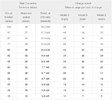Hi All,
Future Tesla owner here trying to figure out exactly what plug setup I need to take advantage of full 32A charging using the Mobile connector. From all my research it sounds like 14-50 would be the only option right? Is there a lower amperage setup that would allow me to charge at 32A safely? What is the max safe charge rate if I had a 14-30 with 30A breaker?
Been doing a lot of research but looking for some guidance from the folks here
PS> My breaker box is currently full. Is it ok to clear out 2 slots of 15A breakers to make room for a 50A breaker? 100A service
Future Tesla owner here trying to figure out exactly what plug setup I need to take advantage of full 32A charging using the Mobile connector. From all my research it sounds like 14-50 would be the only option right? Is there a lower amperage setup that would allow me to charge at 32A safely? What is the max safe charge rate if I had a 14-30 with 30A breaker?
Been doing a lot of research but looking for some guidance from the folks here
PS> My breaker box is currently full. Is it ok to clear out 2 slots of 15A breakers to make room for a 50A breaker? 100A service
Last edited:



